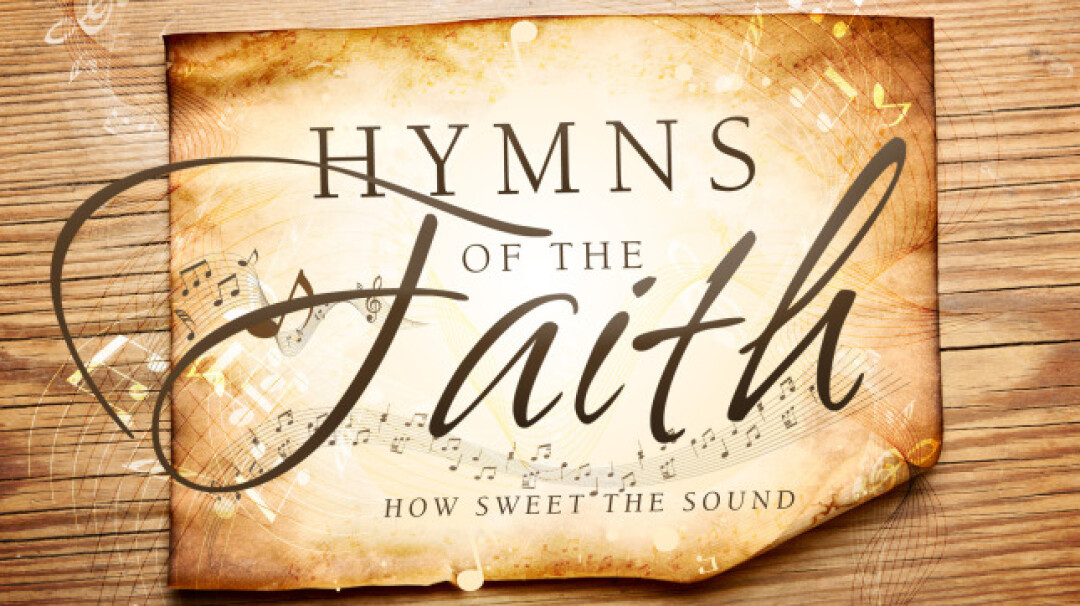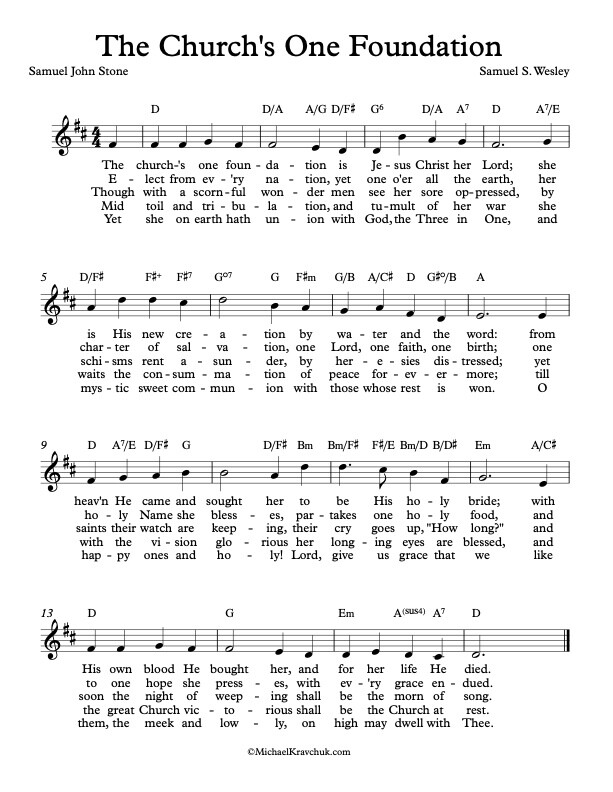

"The Church’s One Foundation”
by Samuel J. Stone, adapted by Laurence Hull Stookey
The United Methodist Hymnal, 546
Original text by Samuel J. Stone
"The Holy Catholic Church:
The Communion of saints.”
“He is the Head of the Body, the Church.”
The Church’s One Foundation
Is Jesus Christ her Lord,
She is His new creation
By water and the Word:
From Heaven He came and sought her
To be His holy Bride,
With His Own Blood He brought her
And for her life He died.
Adaptation by Laurence H. Stookey
The church’s one foundation
is Jesus Christ our Lord;
we are his new creation
by water and the Word;
from heaven he came and sought us
that we might ever be
his living servant people,
by his own death set free.*
*Adaptation © 1983 The United
Methodist Publishing House
SAMUEL STONE’S ORIGINAL HYMN
Samuel John Stone (1839–1900), then a newly ordained curate at New Windsor Parish Church, wrote “The Church’s One Foundation” in 1866 as a direct lyrical commentary to a controversy in the Church of South Africa, part of the Anglican Communion. The controversy was between Bishop John William Colenso of Natal (an early apologist for the new theory of source criticism) and Bishop Robert Gray of Cape Town (apologist for traditional means of dating and tracing authorship in scripture). Stone’s text was a tribute to Gray’s view. The link between this hymn and the Colenso controversy is well-documented. In C. Michael Hawn’s History of Hymns column on the original hymn, it can be read in more detail: https://www.umcdiscipleship.org/resources/history-of-hymns-the-churchs-one-foundation.
The origins of “The Church’s One Foundation” are found in a lengthier publication titled Lyra Fidelium: Twelve Hymns on the Twelve Articles of the Apostles Creed (1866). The text is constructed around ideas from the ninth article, “The Holy Catholic: The Communion of Saints,” bearing a subtitle from Colossians 1:18, “He is the head of the body, the Church,” and embeds portions of at least 38 scripture passages. H.E.C. Stapleton writes,
The strength of the hymn lies in the simplicity and directness of its message, the vividness of its metaphors, and the deliberate, distinct echoes of words and phrases from scripture. In Lyra Fidelium, there are no less than four biblical quotations annotated to each stanza; in one, seven. It was hailed in Stone’s own time as “the battle-song of the Church” (Stapleton, Canterbury Dictionary).
Including this panoply of scripture was likely a result of Stone’s concern with the orthodox position of the primacy of scripture, one of the central points of the controversy. These passages, as noted by Stone, are as follows:
- Stanza 1: 1 Cor 3:11; John 3:5; Eph 5:25–26; Acts 20:28
- Stanza 2: Rev 5:9; 1 Cor 10:17; Eph 4:5; Acts 4:12; 1 Cor. 10:17; Eph. 4:4; Eph. 4:7
- Stanza 3: Matt 16:18; Matt. 28:20; 1 John 3:13; Gal 2:4; Mic 7:8
- Stanza 4: 2 Pet 2:2; 1 Cor 11:18; 11:19; 1 Pet 4:7; Ps 25:22; Rom 8:23; Isa 51:11
- Stanza 5: Eph 6:12; Rom 8:37; Rom 16:20; 1 John 3:2; Heb 4:9
- Stanza 6: 1 John 1:3; 2 Cor 13:14; Heb 12:22–23; Isa 43:2; Luke 23:43
- Stanza 7: Jude 1:24, 1 Pet 5:6; Rev 21:10; Rev. 7:17; Rev 21:3
Two years later, the text was reduced to five stanzas with Stone’s cooperation, resulting in the version most congregations now use. About twenty-two years after its composition, this hymn took its place as a significant lyrical text of the church. Stapleton writes:
The hymn came into its own at the Lambeth Conference in 1888 when it was sung at all the primary services. It is recorded that at St Paul’s Cathedral, its effect was so powerful that the singers were physically overwhelmed: “It made them feel weak at the knees, their legs trembled, and they felt as though they were going to collapse” (Stapleton quoting Wesley Milgate, Songs of the People of God, 1982).
LAURENCE STOOKEY’S ADAPTED TEXT
The adaptation by United Methodist seminary professor and liturgical scholar Laurence Hull Stookey (1937–2016) first appeared in The Upper Room Worshipbook (1983), and then in The United Methodist Hymnal (UMH) following the 1988 General Conference of The United Methodist Church. This was a critical conference concerning the hymnody of the church. The United Methodist Hymnal was adopted at this conference as well as a mandate concerning significantly altered texts, requiring both the original and the altered text to be placed side-by-side. This mandate created space for Stookey’s adaptation, considered to be an “inclusive, ecumenical, and nonsexist” version of the original. This was the only instance in which the mandate of the General Conference was implemented (Young, 1993, p. 629).
Although inclusive language in contemporary hymns is gaining wide acceptance, the adaptation of well-known texts remains controversial and lives in a narrow space, with one side being possible issues of non-equity/non-representation—the other being retention of language that holds to the integrity of the original text. In addition, further divisions arise in churches and church bodies about gendered language, archaic language, and subtle changes of theology from adapted texts. These divisions are far too large a conversation to address in this article. Still, careful reflection on the practice of adaptation does bear on Stookey’s text.
It is interesting to note that Stone’s language, which directly addressed the issues of the 1866 controversy, is largely untouched by Stookey, honoring the original impetus of the text. In stanza three, direct statements align with Stone’s concern when he writes, “by schisms rent asunder, / by heresies distressed.” In stanza 4, there is language that perhaps describes the feeling of the church, saying, “Mid toil and tribulation, / and tumult of our war.” These statements, retained by Stookey, remain faithful to the original wording, though the cultural, historical, ecclesial, and theological contexts differ. Hawn also notes in his article, writing, “The church exists in a constant state of controversy and potential schism. In many ways, this text articulates feelings that are as fresh as ever” (Hawn, “History of Hymns”).
The most noticeable aspect of Stookey’s adaptation concerns Stone’s use of feminine pronouns, drawing on the metaphor of the church as the bride of Christ: “Wives, be subject to your husbands as you are to the Lord. For the husband is the head of the wife just as Christ is the head of the church, the body of which he is the Savior” (Eph 5:22–23, NRSV). The subjugation of women as the context for the ecclesial metaphor is troubling for many Christians. Stone’s text is replete with this metaphor, beginning with the first stanza: “The church’s one foundation / is Jesus Christ her Lord.” This gendering of the church is strongly underscored in the third phrase, “from heaven he came and sought her / to be his holy bride” (emphasis added) and remains present throughout the near entirety of the hymn. It is only in the second half of Stone’s final stanza that we finally sing that “we” are the church referred to in this text.
In Stookey’s adaptation, he replaces feminine pronouns and phrases with “we” language. Often, Stookey is straightforward, substituting “our” and “we” for “her” and “she.” Sometimes, he changes short phrases, such as “one holy name she blesses” to “one holy name professing.” Another short example is the change of text from “and to one hope she presses, / with every grace endued” to “to one hope always pressing, / by Christ’s own Spirit led.” These shorter modifications subtly paraphrase the original—in the first instance, changing the idea of blessing God’s name to professing God’s name. This change shifts us from praising God to making an open declaration of God. In the adaptation, the singers move from being infused with grace to following the leading of the Spirit, both of which are evidence of God’s work within us.
Less frequent are instances of adaptation on a larger scale. The last four lines of the side-by-side texts cited at the beginning of this article exemplify this. This adaptation, quite different in the language used, retains the original ideas of being sought out by Christ and the claim of salvation for the church through the death of Christ but adds the church’s identity as servant people, something not seen in the original text.
Another aspect of Stookey’s adaptation concerns ecumenism and inclusivity in addition to reworking feminine pronouns and images in the text. Stone’s original second stanza begins with “Elect from every nation” (his first draft said, “She is from every nation”). Stookey broadens the meaning in his adaptation— “Called forth from every nation.” The term “elect” may have had its origins in the influence of Calvinism and Reformed doctrine on The Anglican Church at this time. The clause, “from every nation,” may reflect England as a world political and military power at the height of its colonial influence around the world. The Anglican communion was a worldwide catholic (universal) church. The idea of the “elect” of God is a crucial doctrinal distinct from one embraced by the United Methodist Church. By changing “Elect from” to “Called forth,” Stookey reflects the Wesleyan doctrine of free grace and universal availability of prevenient grace to all people.
These are, by far, not the only issues taken up by Stookey in his adapted text that bear further discussion. By changing the perspective from third person (feminine) to the first-person plural, Stookey changes our idea of ecclesiology—the nature of the church. Perhaps we can consider these initial understandings, recognizing Stookey’s offering as a theological reflection that moves our sung faith toward non-binary gendered language and allows for the inclusion of all among Christ’s called. The church’s ministry and our perception of the church in the twenty-first century are changing. Thankfully, we rest on the tradition of the saints but must also sing a faith that is vibrant and efficacious in our time.
Laurence Hill Stookey was a beloved professor of preaching and worship at Wesley Theological Seminary, Washington, D.C., from 1973–2007. Many consider Laurence Stookey to be among the four most influential United Methodist liturgical scholars of the later twentieth and early twenty-first centuries. This list includes Hoyt Hickman (1927–2016), James W. White (1932–2004), and Don Saliers (b. 1937). They worked together to reform Protestant worship following the Second Vatican Council (1962–65) by emphasizing the Revised Common Lectionary. Additionally, they collaborated on the United Methodist Book of Worship (1992) and the Handbook of the Christian Year. Stookey came out of the Evangelical United Brethren tradition, helping United Methodists appreciate the “United” part of their heritage.
Stookey was a native of Illinois, graduating from Swarthmore College, Wesley Theological Seminary, and Princeton Theological Seminary. He was also a gifted musician who enjoyed playing several instruments. His creative and practically written trilogy of texts has proven invaluable to students and pastors. They include: Baptism: Christ’s Acts in the Church (1982), Calendar: Christ’s Time for the Church (1996), and Eucharist: Christ’s Feast with the Church (1993). If you participate in a baptismal liturgy in a United Methodist Church, you will likely hear and speak words by Laurence Stookey.
SOURCES:
Heather Hahn and Sam Hodges, “Remembering Professor who Shaped Worship,” United Methodist News (October 20, 2016), https://www.umnews.org/en/news/remembering-professor-who-shaped-worship (accessed September 12, 2021).
Stapleton, H.E.C., “The Church’s One Foundation,” Canterbury Dictionary of Hymnology, http://www.hymnology.co.uk/t/the-church’s-one-foundation (accessed September 12, 2021).
Rowan Strong, “Lambeth Conference, First Participants,” Oxford Dictionary of National Biography (April 12, 2018), https://www.oxforddnb.com/view/10.1093/odnb/9780198614128.001.0001/odnb-9780198614128-e-107600 (accessed September 12, 2021).
Carlton R. Young, Companion to The United Methodist Hymnal (Nashville: Abingdon Press, 1993).
Victoria Schwarz is a provisional deacon in the Rio Texas Conference and serves as the Associate Pastor and Minister of Music at Berkeley United Methodist Church in Austin, TX. She is active in the Fellowship of United Methodists in Music and Worship Arts.
Adapted from https://www.umcdiscipleship.org/articles/history-of-hymns-the-churchs-one-foundation-2021


